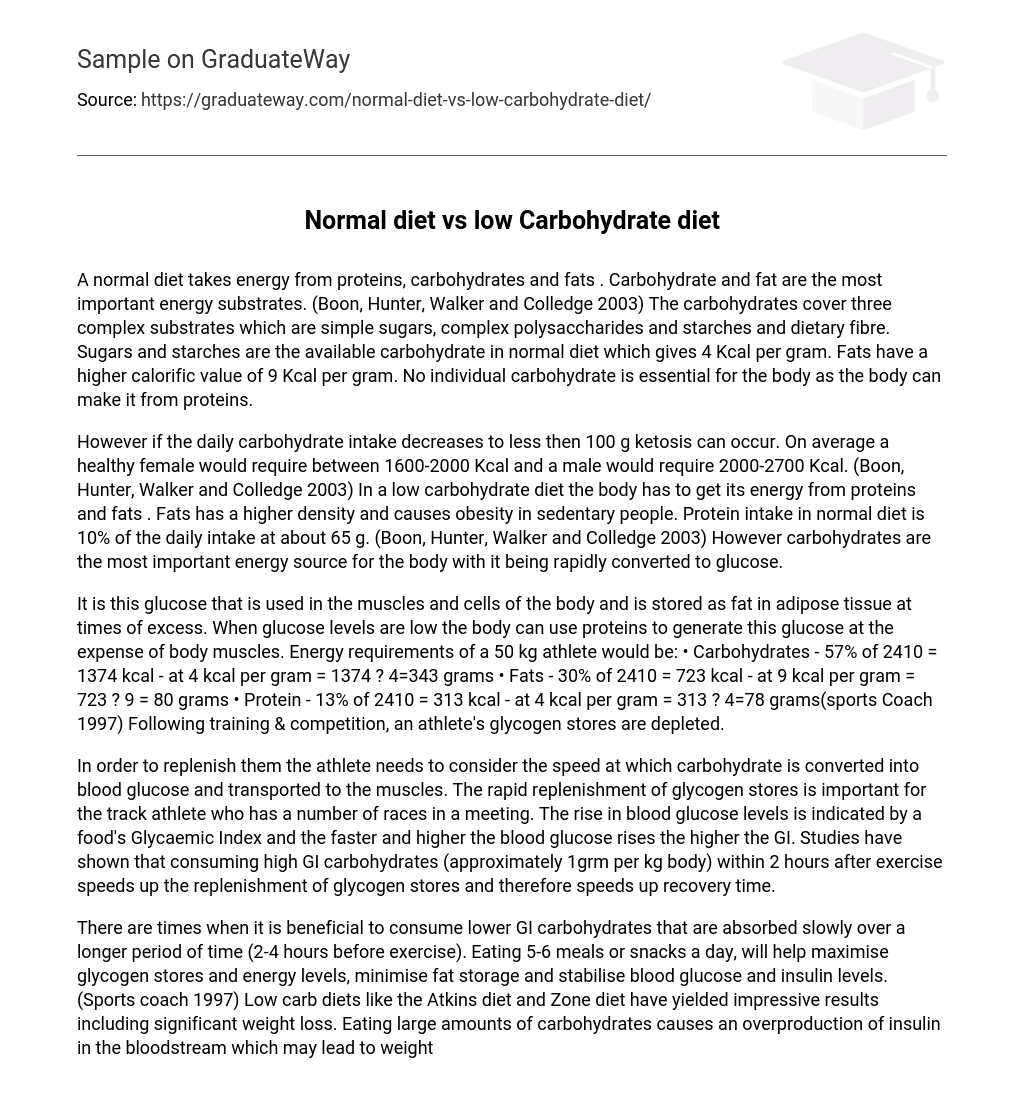A normal diet takes energy from proteins, carbohydrates and fats . Carbohydrate and fat are the most important energy substrates. (Boon, Hunter, Walker and Colledge 2003) The carbohydrates cover three complex substrates which are simple sugars, complex polysaccharides and starches and dietary fibre. Sugars and starches are the available carbohydrate in normal diet which gives 4 Kcal per gram. Fats have a higher calorific value of 9 Kcal per gram. No individual carbohydrate is essential for the body as the body can make it from proteins.
However if the daily carbohydrate intake decreases to less then 100 g ketosis can occur. On average a healthy female would require between 1600-2000 Kcal and a male would require 2000-2700 Kcal. (Boon, Hunter, Walker and Colledge 2003) In a low carbohydrate diet the body has to get its energy from proteins and fats . Fats has a higher density and causes obesity in sedentary people. Protein intake in normal diet is 10% of the daily intake at about 65 g. (Boon, Hunter, Walker and Colledge 2003) However carbohydrates are the most important energy source for the body with it being rapidly converted to glucose.
It is this glucose that is used in the muscles and cells of the body and is stored as fat in adipose tissue at times of excess. When glucose levels are low the body can use proteins to generate this glucose at the expense of body muscles. Energy requirements of a 50 kg athlete would be: • Carbohydrates – 57% of 2410 = 1374 kcal – at 4 kcal per gram = 1374 ? 4=343 grams • Fats – 30% of 2410 = 723 kcal – at 9 kcal per gram = 723 ? 9 = 80 grams • Protein – 13% of 2410 = 313 kcal – at 4 kcal per gram = 313 ? 4=78 grams(sports Coach 1997) Following training & competition, an athlete’s glycogen stores are depleted.
In order to replenish them the athlete needs to consider the speed at which carbohydrate is converted into blood glucose and transported to the muscles. The rapid replenishment of glycogen stores is important for the track athlete who has a number of races in a meeting. The rise in blood glucose levels is indicated by a food’s Glycaemic Index and the faster and higher the blood glucose rises the higher the GI. Studies have shown that consuming high GI carbohydrates (approximately 1grm per kg body) within 2 hours after exercise speeds up the replenishment of glycogen stores and therefore speeds up recovery time.
There are times when it is beneficial to consume lower GI carbohydrates that are absorbed slowly over a longer period of time (2-4 hours before exercise). Eating 5-6 meals or snacks a day, will help maximise glycogen stores and energy levels, minimise fat storage and stabilise blood glucose and insulin levels. (Sports coach 1997) Low carb diets like the Atkins diet and Zone diet have yielded impressive results including significant weight loss. Eating large amounts of carbohydrates causes an overproduction of insulin in the bloodstream which may lead to weight gain.
If there is too much sugar in the bloodstream, the body will respond by turning this sugar into fat. On the low carb diet, individuals are consuming less than the recommended carbohydrate intake of the National Academy of Sciences (NAS). The NAS recommends no less than 120 grams of carbohydrates per day. However, most low carb diets actually consist of a ratio of carbohydrates which fall well below the set guidelines. Advocates of the low carb diet argue that there have been numerous studies which prove that low carb diets raises HDL (the so called ‘good’ cholesterol’) and links low carb diets to the prevention of heart disease and diabetes.
However, presently the benefits of low carb diets have not been sufficiently validated by the health community. (Health weight community) It is frequently claimed that a VLCARB sets the stage for a significant loss of muscle mass as the body recruits amino acids from muscle protein to maintain blood glucose via gluconeogenesis. A VLCARB is almost always relatively high in protein. There is evidence that high protein intake increases protein synthesis by increasing systemic amino acid availability which is a potent stimulus of muscle protein synthesis.
During weight loss, higher protein intake reduces loss of muscle mass and increases loss of body fat. (Manninen, A. 2006) It is still the subject of a lot of debate as to whether low carbohydrate diets are harmful or not. It remains to be seen whether a high protein diet is more damaging then a high carbohydrate diet. Certain instances have shown that it is beneficial in weight loss. However an athletic person would need a fair amount of carbohydrate in his diet.





